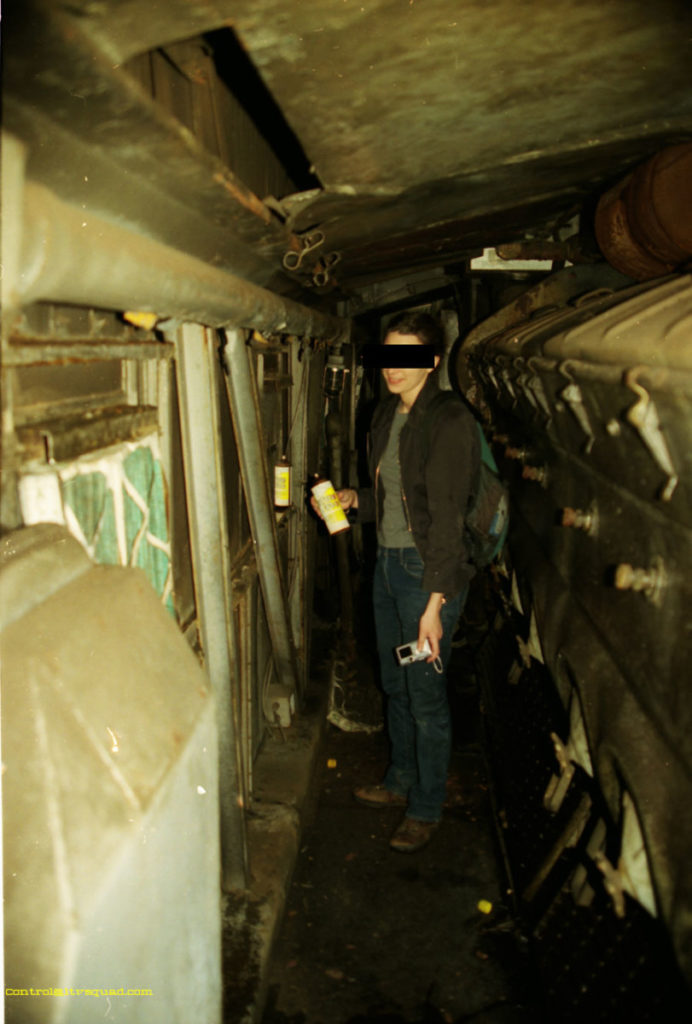In 2002 we stopped by Metro North’s graveyard to poke around the oddball collection of junk commuter train equipment stored and awaiting a date with either the scrappers torch or, less likely, resale and restoration. This collection of locomotives and rail cars represented some of the best and worst in terms of reliability & design.
FL9s
In terms of design, the FL9’s were classic ‘cab’ units. They were built to run off both a standard diesel engine or 3rd rail power, for operation into Grand Central Terminal. They were originally built in the 1960s for the New Haven Railroad, which was later absorbed into the doomed Penn Central railroad (which went bankrupt), then Conrail, and eventually the MTA.
During the Penn Central years, locomotive maintenance was always a problem. There were never enough spare parts to go around: “My first working assignment was FL9s, and considering the way they were maintained under Penn Central it is a miracle they were able to operate at all. I recall many of them were missing some of the third rail pickup shoes as the railroad was constantly out of stock and could not afford to buy them. You could look back in the engine room when running on third rail and watch the light flashes as electrical equipment dropped out and picked up under full load. This kind of abuse of course ultimately cost the railroad much more in equipment repair expenses than the cost of putting on a full set of shoes, but that could all be conveniently blamed on EMD to hide the reason it was really happening. ” – P Cook. (Comment found here, accessed 8/2015).
Despite the abuse, the majority of FL9 locomotives saw regular usage into the early 2000s, and the last were ‘retired’ from Metro North in 2009.
3 of the FL9s present (and seen in these photos) wrapped up their careers on the Long Island Railroad, as part of the 1990s experimental use of bi-level cars on diesel hauled trains to the far reaches of the island. This successful experiment resulted in the LIRR replacing its entire diesel haul fleet of passenger cars with bi-level cars and newer locomotives. While on the LIRR, they were numbed 300, 301 and 302. 300 and 302 were the most reliable, while 301 was used as a back up. Of note – 301 was originally New Haven #5000 – one of the first FL9s constructed (in 1957). As you can see in these photos, 301 was in the worst shape of the lot, and was ultimately cut up for scrap metal along with the other former LIRR engines.

M checking out the engine lube..
Metro North 2010 was also in this line of dead engines – it however survived and is on the Cooperstown & Charlotte Valley Railroad in upstate NY. Currently it’s not in use, though word is that they have a second FL9 (2028) currently being repaired. Even if 2010 never runs again, some of its parts will likely keep the other running for years to come.
M1A’s
The M1 cars were produced in the hundreds. They’re far less unique than anything else found in this junk collection, but they were notable for when they were placed in service in the 1970s, they were some of the first Metro North cars to have air conditioning.
I’m not quite sure why this single M1 car was at the graveyard, so if you have any info, be sure to comment. Unfortunately I have no idea what the car number was. (It’s also possible that this was an M3 car, since they look so similar…)

SPVs
The SPVs, or ‘seldom powered vehicles’ were a failed replacement for the far more reliable Budd RDC cars. These self-powered passenger cars were purchased by the MTA for use on shuttle trains from Poughkeepsie to the electrified rail at Croton (where passengers would switch to a train of M1A or M3 cars). These cars were highly unreliable, and often had to be pulled by diesel locomotives.
Together, this collection of battered passenger cars and locomotives hauled commuters from point A to point B in the best and worst of times. The technology behind them has been built upon in the current generation of commuter rail equipment. For example, the 1990s LIRR bi-level test (powered by the FL9s) resulted in a larger purchase of diesel/electric locomotives and bilevel cars in the late 1990s – nearly all of which are still in use today.
Very interesting looking @ the retired equipment on the tracks. Concerning the MU car, it looks like it might be an M3. Those were great pix of the engine room Having done restoration work on E units, I enjoy seeing what makes a locomotive pull. Many years ago, I saw photos of the same area, and there was equipment dating back to the early days of the GCT electrification.
The MU might be 9776. Wrecked in the 90s.
BL – Do you recall where the wreck was? I’ll see if I have a better photo showing its number.
The SPV 2000 cars in CT were later demotorized.
They had no problems after that and were used on Shoreline East Service.
There is one that is stored in Danbury Railway Museum and may be on further display by the private railcar owner.
Good work Joe. I’m a railfan for over 60 years. My dad brought us kids down to the Tremont station in the late 50′ s and I was awed by the sheer power of the engine’s. I took those RDC and seldom powered units to and from Poughkeepsie and remember the engineer complain how slow it was. He kept banging on the throttle.
Where is this graveyard at?